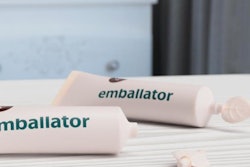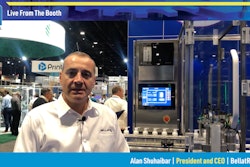More manufacturers are turning to palletizing operations with collaborative robots (cobots), and ONExia is a system integrator that has made it easier for its clients to use cobots as a drop-in replacement for end-of-line workers. With the drag-and-drop software that comes with the PalletizHD collaborative palletizing system, anybody can program the cobot easily to achieve the desired palletizing operations.
Tim Pelesky, marketing manager for ONExia, was in Lakeside Center to demonstrate how easy it is to set up the system. Users have complete control of the entire system through the embedded touchscreen on the PalletizHD lifter base. To create a program, a user can touch the screen to select a new pallet configuration, and then add box dimensions (weight, length, width, and height) and pallet dimensions (length and width). “We also offer a box edge gap in the event that you’re worried that your boxes might not be completely uniform or your pallet configuration requires it,” Pelesky says, noting the ability also to create a reference edge. “We also offer the ability to do a dual pick in the event that you want to pick two boxes at one time using the 38-lb payload.”
Once the box and pallet parameters are entered, it’s time to create your pallet configuration. “To get started to create your first layer, press the plus, hit Edit Layer, and your boxes are on the screen ready to go. All you’ve got to do is drag and drop them into place. There’s no programming; nothing like that,” Pelesky says. “Once you’ve completed your entire layer, you’re able to center it left and right and up and down to make sure the robot’s going to place a good and tight pallet configuration.”
After the first layer is created, it’s easy to copy and paste it as the next layer or customize each layer differently.
“The last step in building this pallet is we have to teach certain points because we’re not using any integrated vision,” Pelesky says. Just two points need to be taught—the nesting position, where the box comes from the infeed conveyor; and the first-place position on one of the pallets.
“You would then come over, hit that button where the position’s taught, and then you’re able to mirror it on the other side,” Pelesky says. “The last step would be to press save, go back home, and all of your pallet configurations are there, ready to go, on the fly, and can be adjusted as production changes within the line.”
Users can easily save and recall different pallet configurations based on production demands.





























